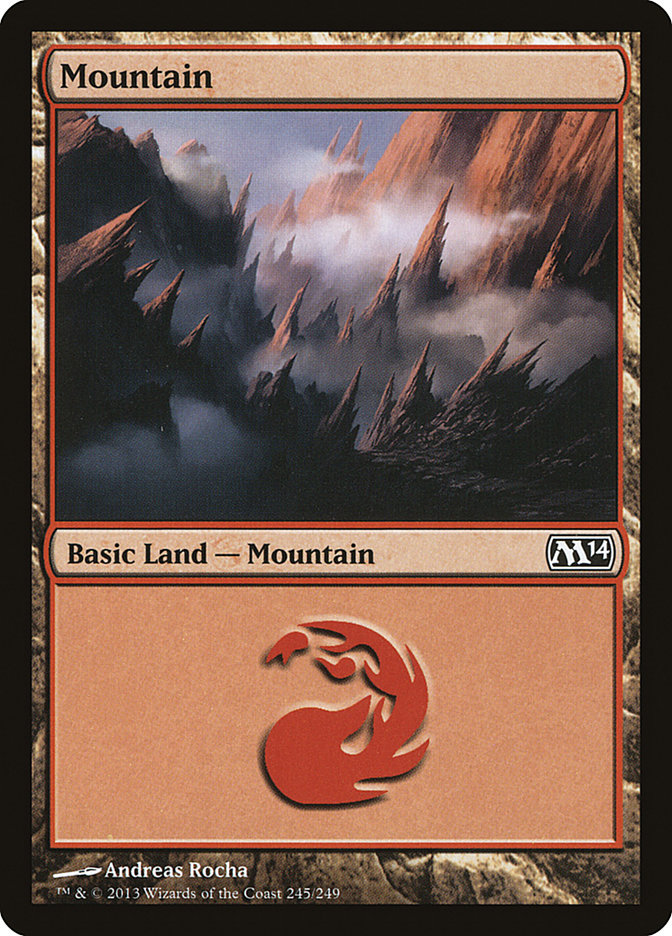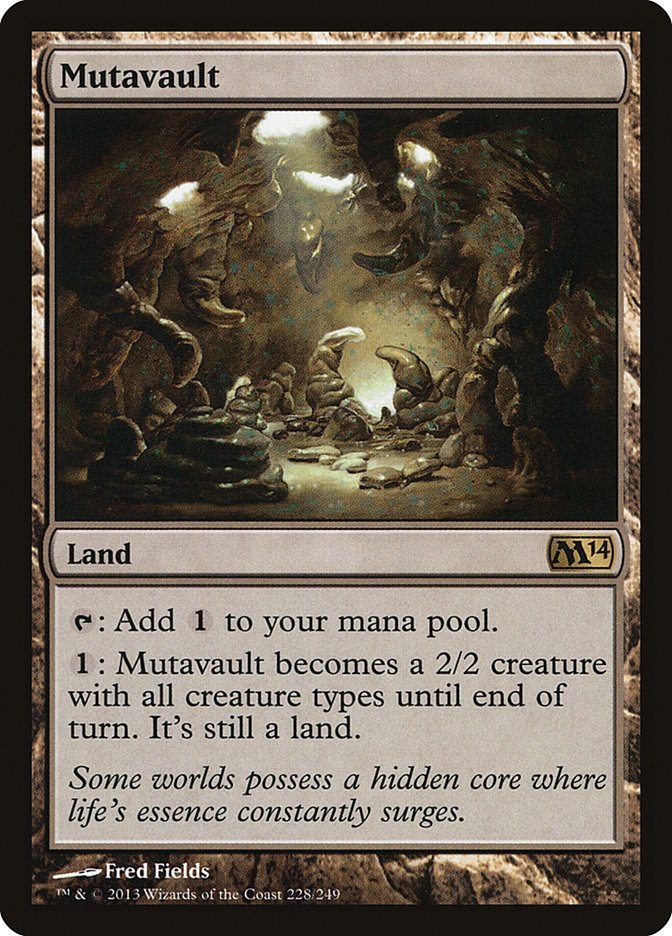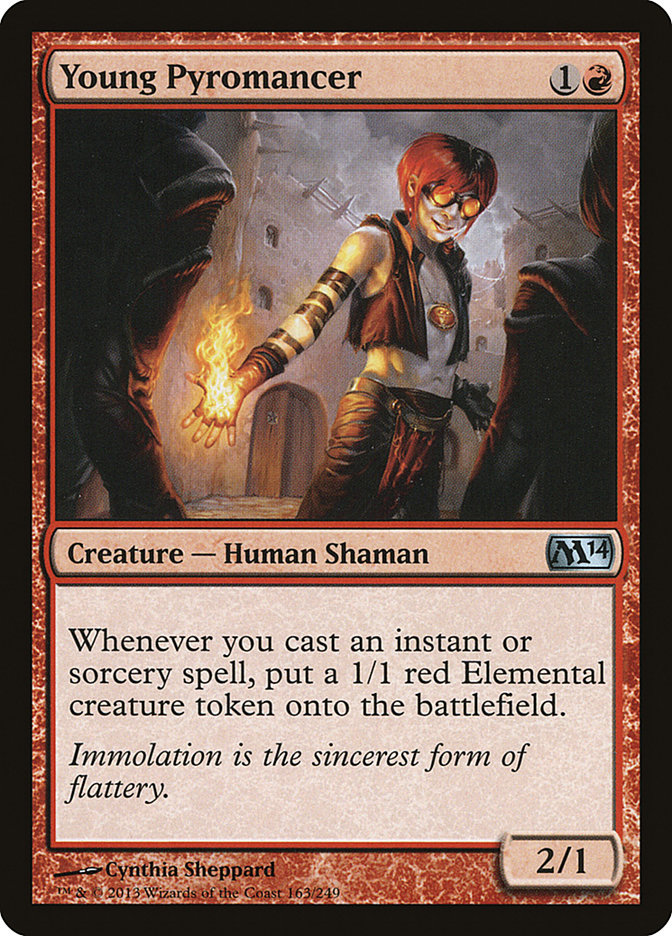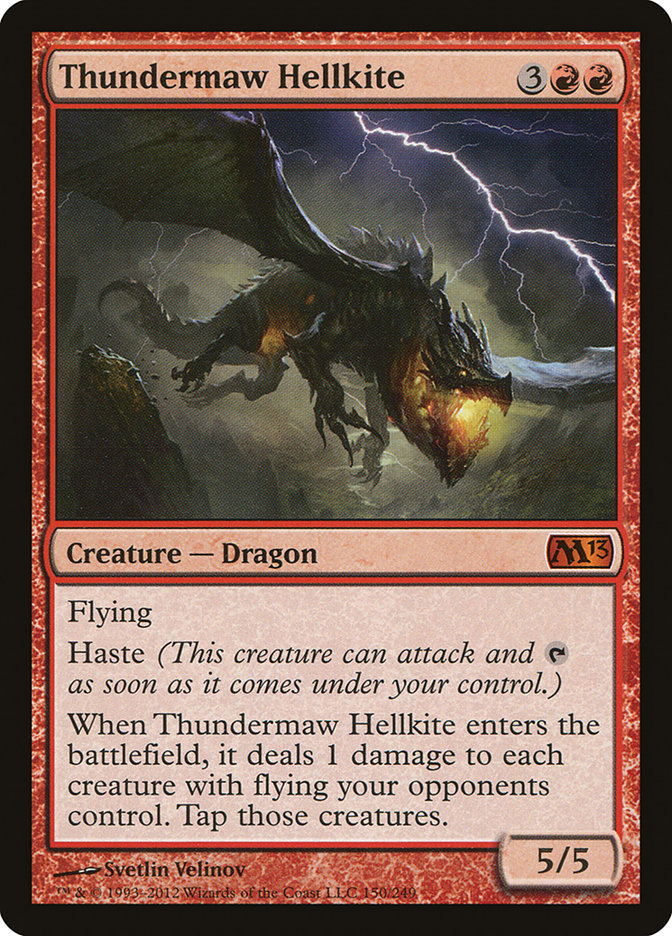Let me level with you.
There are only two kinds of people in this world:
1. The ones that can kill your Young Pyromancer.
2. Everybody else.
Oops. Sorry. I lied. Actually there are three kinds of people in this world:
1. The ones that can kill your Young Pyromancer.
2. Everybody else (except for Bant Hexproof).
3. Bant Hexproof.
And really, eff Bant Hexproof. These are terrible people. Unflinching Courage and Fiendslayer Paladin now? Don’t you think that is a little excessive? How can you sleep at night making poor mono-red mages frantically chew their fingernails to the beds every round? I mean really. Back when I played Bant Hexproof, I thought Loxodon Smiter was the best card in the 75 because it let you win fair games against beatdown. Jay-sis was I naive.
But now I sympathize with the other side.
I have mostly been playing this for the past week or so, trying to get good at it.
It is sweet / awesome / what Patrick Sullivan would call "satisfying":
Creatures (8)
Planeswalkers (3)
Lands (25)
Spells (24)
- 4 Shock
- 4 Brimstone Volley
- 1 Geistflame
- 4 Pillar of Flame
- 4 Flames of the Firebrand
- 4 Searing Spear
- 3 Mizzium Mortars
Sideboard

The inspiration comes from two places, both of which are probably predictable:
1. Adam Laforest’s Top 8 deck from Grand Prix Calgary. What a giant leap for mankind in the context of Ravnica duals! I remember being puzzled when Adam made Top 8. Everything in his deck was expensive; how did he beat control and / or powerhouse decks? I have since learned to respect his deck as more than a flaming oddity that must have gotten lucky (over and over and statistically improbably over again). Got beat up by it a couple of times online—great starting point.
2. Drew Levin Legacy article from last week Young Pyromancer: The Cycle is Complete—I think (and at least 144 other people agreed)—a crowd-pleaser. Young Pyromancer is indeed an exciting little two-drop (you know, in a game largely defined by great two-drops).
Baselines and Biases
Any deck that is similar to an archetype deck but substantially different in order to take advantage of a specific card, synergy, or strategy is going to be biased in some way. Often these decks will be missing something Staple (sorcery-loving Vore played Eye to Nowhere over Boomerang; tribal beatdown Goblins decks don’t main Lightning Bolt). Rarely will such biases yield a more flexible or generically more powerful deck, which says nothing as to whether that produces a deck of greater or lesser expectation than the default.
This Pyromancer deck has some structural similarities to Laforest’s 25-land Big Red from Calgary, but instead of cornering the opponent into Burning Earth in game 1 (a fine if different strategy, mind you), its Flagship centerpiece is Young Pyromancer. It can cast cards, trade cards, etc. but operates on a different level when Young Pyromancer is on the battlefield. Almost everything is chosen to make Young Pyromancer better; even non-instant / non-sorcery Chandra, Pyromaster helps draw more instants and sorceries, more land to cast more instants and sorceries, or makes particular instants and sorceries contextually more effective like finishing off an opposing Thundermaw Hellkite after a Mizzium Mortars has already produced a 1/1 Elemental Token.
The deck will, generally speaking, win in one of two-and-a-half ways:
1) Young Pyromancer deck – Its favorite way of playing is using Young Pyromancer to either generate or deflate tempo. The deck’s favorite opponents are G/W Elves or—somewhat non-intuitively—historical red deck thumpers G/W creature decks [that tend to be removal-poor]. It can get either tempo-neutral trades like Shock for Elvish Mystic or card advantageous ones like Flames of the Firebrand for this, that, and one to you while producing 1/1 Elementals.
When a deck is spending all its cards as removal on opposing creatures, there is a danger that it will just run out (threat decks historically play fewer lands than control decks, so they tend to be out-carded playing card-for-card in long games). At that point the opponent will gain / regain the advantage in materiel and overcome any removal plan. Elsewise the removal deck will fall back on a big card advantage spell like Sphinx’s Revelation or Blast of Genius to reload and continue killing stuff (notice how much mana consumption that implies).
Young Pyromancer actually creates a different paradigm where the removal itself is transformed into threats, so every time you kill something you are producing more and more offensive power. That means counterstrikes are delicious! Young Pyromancer can also be used to cut down the opponent’s tempo and pressure, like a souped-up Lingering Souls. As long as there is no Unflinching Courage in play, a 1/1 Elemental will block a Loxodon Smiter. In fact, there is the danger that it will block, put a point on the 4/4, and then at the end of turn draw up a Searing Spear that will finish off the Smiter and replace the Elemental. In a war of fair decks, the unchecked Young Pyromancer is close to king.
2) Philosophy of Fire deck – The deck has sufficient red cards to win games on turn 5 with or without Thundermaw Hellkite. I mean, you can just DO THIS. Racing is actually one of the best strategies against decks like Bant Hexproof that will generally win the long game and can present eight or more lifelink threats in game 1. Trying to win on turn 5 might also be very favorable against Sphinx’s Revelation decks, shaving off their ability to build advantages. Both especially true in sideboarded games where Skullcrack can lend a hand.
Now, as I’ve said, games where you draw Young Pyromancer (or your Young Pyromancer lives) are like playing a different deck from games where you don’t (or it doesn’t). This is much like Kuroda-style Red where games where you drew Sensei’s Divining Top allowed you to regulate your drawing of lands vs. burn cards perfectly versus being subject to (or victim of) the caprices of Fortuna. The problem with just playing straight burn is that sometimes you have to send cards at creatures. That is an exchange of potentially explosive one-time packets of damage at renewable resources. The math doesn’t add up there in the long term. Like we said, before decks falling into the "trade my hand for your battlefield" paradigm end up either being overwhelmed by the opponent’s threats [anyway] or having some kind of card advantage engine that keeps the ball rolling.
In this deck, the latter strategy is fueled at least in part by the decision to play Chandra, Pyromaster over Burning Earth maindeck. This leads to all manner of potentially interesting eventualities and operations. Chandra can draw you extra removal / burn cards (or the lands to play them), or she can pick off small creatures at a reasonable rate while damaging the opponent and preventing you from falling behind. I actually find these games to be some of the most interesting and rewarding to play because they are hard to predict from the opponent’s side but can go in wildly different directions depending on how you choose to execute. Should I get small value on the [+1] or roll the dice on the [0]? Am I playing a Howling Mine game or trying to level up to Ultimate Limit Break?
The best might be a situation where you are able to stockpile cards, play a Young Pyromancer with a full grip, and then respond to your opponent’s reaction by taking a big turn. The worst (which has actually happened to me) might be leveling Chandra up past eight or nine against, say a Thragtusk’s remainder 3/3 Beast and a Desecration Demon, going Ultimate Limit Break for ANY OF Searing Spear, Brimstone Volley, or Arc Lightning Flames of the Firebrand, being stuck with a Shock / Pillar of Flame, and losing your Chandra to the stupid Beast the next turn. Regardless, because these games lack the domination of an unchecked Young Pyromancer, they tend to yield long and interesting Stage Twos. If you’re into that kind of thing.
2.5) Thundermaw Hellkite plays fairy godmother – For the longest time, I played no Mizzium Mortars and no Thundermaw Hellkites. Mizzium Mortars seemed largely at odds with the Philosophy of Fire plan, and Thundermaw Hellkite was JUST. ONE. MORE. card that didn’t fit into the Young Pyromancer plan (above and beyond basically just Chandra, which has long-term synergy with Young Pyromancer if not short-term). But I lost one too many games to Lingering Souls, which seemed impossible for a deck with Flames of the Firebrand, and I was losing to Big Red and to a lesser extent Dragonmaster G/R due to one card.
“If you can’t beat ’em, join ’em.”
–Future Magic Online boss Worth Wollpert, October 1996 on the occasion of my first PTQ win, with—wait for it—Necropotence
I scoured Gatherer and could find nothing that was a great, consistent solution to Thundermaw Hellkite (Thunderous Wrath, maybe?) and decided all these big aggressive decks might be doing something right. Which is how I adopted their Dragon.
If you think about it, Young Pyromancer is a super powerful card. So is Thundermaw Hellkite!
Burning the opponent to death [quicky] is awesome—Thundermaw Hellkite can act like a super-efficient burn card! Five mana = five to the face!
Sign me up?
Strategy, Tactics, and 80s References
Delayed Blast Fireball
Believe it or not, it is sometimes optimal to leave your Young Pyromancer in hand on turn 2! I know, I know . . . this seems antithetical to a deck like this. Don’t you want to get in for two michaelj? Isn’t leaving two mana unspent anathema to winning with limited resources michaelj?
At Level Zero, the answers to both of those questions are of course yes and yes.
But we aren’t always playing Level Zero Magic, are we?
Sometimes some crimes go slipping through the cracks. And sometimes you can pick up the stink of a banana peel or the smoldering cojiba of an incoming Pillar of Flame from the opponent’s first land drop. LEAVE YOUR YOUNG PYROMANCER HOME!
I know it feels wrong. I know it will be tough—a struggle even—to wait until turn 3 / when you have three untapped mana on the ‘field to deploy your Young Pyromancer. But at least when you do this, you can respond to a Tragic Slip by producing a little value. Delayed Blast Fireball is spectacular against Devour Flesh of course.
Double Dragon
The spiritual twin of Delayed Blast Fireball but its operational opposite, Double Dragon is also non-intuitively an exercise in patience. Yes, you might play your FIRST Young Pyromancer on turn 2, but you will immediately play the second ASAP.
Where you want to eke a tiny bit of value [you might not otherwise be able to action whatsoever] off a Young Pyromancer against a point removal deck with Delayed Blast Fireball, Double Dragon’s goal is to overwhelm decks that already can’t beat a Young Pyromancer. Go crazy!
Every instant or sorcery is a double up. Simple. You forego one-to-two motes of impulse for substantially greater payoffs over time. Geistflame for two 1/1 Elementals on turn 3 followed by a Flashback for two more 1/1 Elementals? I know this is a "fair" strategy but it can feel pretty filthy once it gets going. I bet you thought that Loxodon Smiter was going to be pretty good against basic Mountain too.
Risky Business
A dilemma that comes up in something like 20% of all matches is one of geography:
 |
or |
 |
Why Mountain? Simple—you might have something to do with the mana, and you might have something to do it to. Example: your opponent plays an Avacyn’s Pilgrim, and you want to start up a game of Ha Ha Dead Elf.
Why Mutavault: Simple—AVARICE. You want to get in for two, which in a red deck is like a free card. You are foregoing the ability to tap for R on turn one in order to potentially cash in on two-thirds of a Lava Spike on the second turn.
After dozens and dozens of games where I greedily chose Mutavault, I can tell you that it has almost never paid off. The risk is between one-to-three mana (sometimes you won’t even attack if the path is clear on account of the first land opposite being a Mountain), and I have felt stupid every single time my opponent opened on Arbor Elf or Dryad Militant.
It may just be the composition of the metagame (as good a reason as any if you think about it), but Mountain has earned substantially better on turn 1 than Mutavault. Because the deck is highly reliant on having three-plus mana in play to operate Young Pyromancer and four-to-five mana to cast Chandra, Pyromancer or Thundermaw Hellkite, you really don’t want to risk a Mutavault on turn 2 for a pathetic payoff equal to a less flexible (but more expensive) Shock.
Mutually Assured Destruction
Ratchet Bomb—I don’t like it. I don’t expect you to like it. You gotta do what you gotta do. PSulli once won a Standard Open with four of these buoying up his red deck from the sideboard. Unflinching Courage (or what’s wearing it), Fiendslayer Paladin, etc. I once had to blow up my own Thundermaw Hellkite to kill an Archangel of Thune. Didn’t like it then, but would do again.
Trading Places
One strategy that a creature-poor (but not creature-less) deck like this one might go for between games is to—gasp!—sideboard out some or even all of its creatures between games. It’s like [author name="Matt Costa"]Matt Costa[/author] recently said—he loves Snapcaster Mage but will side it out against Jund’s graveyard-hostile sideboard configuration. The best win I had all week, I think, was against B/G Midrange. I didn’t even have a good draw! In fact, I was stuck on three lands for several turns!
My opponent had every Sign in Blood, hit a line of Lifebane Zombies (never hit a green or white creature / all died to Chandra obviously), and curved up to Desecration Demon like he was supposed to. Maybe the only cool play I made was to activate Mutavault during combat so I could sacrifice it to his Demon—not just to skirt some damage but to line up Morbid. Boom goes the dynamite. The only particularly interactive stuff I did was to respond to his Disciple of Bolas with Skullcrack.
The trick was that he had a hand full of Tragic Slips and Doom Blades. He had a pretty full hand for most of the game, but the cards were largely irrelevant. I assume he kept in Mutilate even because of its ability to undo a strong Pyromancer opening + he actually killed a Thundermaw Hellkite with one in game 1. I know it might seem odd to side out your centerpiece Flagship and your ace, but when the opponent is just going to have a ton of removal—an excess of removal—then picking another path could be the most profitable strategy. Likely you will never get money with either, but the threat of violence can put the fear of The Fear in the other player.
Certainly not going to make for an obvious read. You’ve got tons of great alternates available in the side.
It Must Have Been Love (but it’s over now).
At least for this week.
P.S. Fireblast you.
LOVE
MIKE



